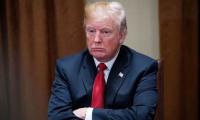SAN FRANCISCO: Intel Corp, the world´s biggest chipmaker by revenue and a prominent U.S. manufacturer, could avoid the most severe effects of a new list of Chinese tariffs proposed by U.S. President Donald Trump by shifting its production among its facilities, analysts said on Monday.
On Friday, Trump said he planned to push ahead with tariffs on $50 billion worth of Chinese imports.
While chips were largely spared from the initial list of targeted goods released in April, U.S. trade officials on Friday released a second tariff list of 284 products worth $16 billion that includes the processor and memory chips at the heart of Intel´s business.
Those tariffs will not go into effect until after a public comment period, and there is a chance that chips could be cut from it before it is made final, analysts said.
But Intel shares dropped 3.4 percent to $53.22 on Monday on news of a stock downgrade and investor concerns over tariffs.
Late Monday, Trump also announced he might pursue $200 billion more in tariffs on Chinese goods, though it was unclear whether the list would include more chips or computing products that might impact Intel. Intel could shift its production strategies to avoid much of the blow. Intel produces raw chips at six so-called wafer fabs, with three in the United States, one in Ireland, one in Israel and one in China.
From there, chips go to so-called assembly and test facilities. After that, they are sold to Intel´s customers, large computer brands or contract manufacturers who work on their behalf. Most of those entities are legally based in China because that is where most electronics are built, and that explains why Intel booked $14.8 billion in China revenue in 2017.But it is Intel´s $12.5 billion revenue from the United States that is at risk. If Intel makes a chip at its U.S. plants in Oregon, Arizona or New Mexico, then sends it to China for low-level assembly work and then brings it back so it can be put into a device manufactured in the United States, the chip would get hit by the tariff. But Intel also has assembly and test centers in Costa Rica, Malaysia and Vietnam.
Chinese power company had intended to acquire up to 18.336 billion ordinary shares of K-Electric, representing 66.4...
MARI also successfully drilled and tested another appraisal well in the Mari Ghazij formation located in Mari D&PL
Gold rates decreased by $30 to $2,381 per ounce in the international market
Growing number of Americans have seen their savings dwindle as rising prices squeeze budgets while interest rates stay...
IMF will closely watch the privatization of PIA by the end of June
PSX lays down the groundwork to encourage listed companies to adopt ESG reporting in line with global standards







